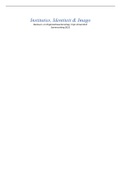Instituties, Identiteit & Imago
Bestuurs- en Organisatiewetenschap, Vrije Universiteit
Samenvatting 2022
,Inhoudsopgave
Instituties, Identiteit & Imago 1
Inhoudsopgave 2
College 1: Industrie creatie vanuit een historische context 4
Aldrich & Fiol (1994) Fools rush in? The institutional context of industry creation. 4
David, Sine & Haveman (2013) How institutional entrepreneurs legitimated the professional form of
management consulting 5
College 2: Institutionele theorie 7
DiMaggio & Powell (1983) Institutional Pressures 7
Suddaby, R., & Greenwood, R. (2001). Colonizing knowledge: Commodification as a dynamic of
jurisdictional expansion in professional service firms. 7
Oliver (1991): strategic responses to institutional processes 8
Gastcollege Arnaud Cohen Stuart: Stranded Assets and Thermal Coal 11
College 3: Stakeholdermodellen en sociale media 12
Mitchell, Agle & Wood (1997): Toward a stakeholder identification and salience 12
Elsbach, & Sutton, (1992). Acquiring organizational legitimacy through illegitimate actions: A marriage of
institutional and impression management theories. 13
Mainardes, Alves & Raposo (2012): A model for stakeholder classification and stakeholder relationships 14
Etter, Ravasi & Colleoni: Social media and the formation of organizational reputation 14
College 4: Identiteit, Imago & Crisis communicatie 15
Dutton, & Dukerich, (1991). Keeping an eye on the mirror: Image and identity in organizational adaptation
15
Hatch & Schults (2002): Dynamics of organizational identity 16
Coombs (2007): Protecting organization reputations during a crisis: The development and application of
situational crisis communication theory 17
College 5: Audit Society, Commensuration & Rankings 19
Power, M. (2004). The risk management of everything. 19
Espeland, W. N., & Stevens, M. L. (1998). Commensuration as a social process. 19
Sauder & Espeland (2009): The discipline of rankings: Tight coupling and organizational change. 20
College 6: Lobbyen & gastcollege Karien van Breugel 21
Hillman, A. J., & Hitt, M. A. (1999). Corporate political strategy formulation: A model of approach,
participation, and strategy decisions. 21
College 7: Professies, Professionals & Identiteit 24
Shore & Wright (2018): How the Big 4 got big: Audit culture and the metamorphosis of international
accountancy firms 24
Addison & Mueller (2015): The dark side of professions 26
, Suddaby, Saxton & Gunz (2015): Twittering change 26
College 8: Professionals, Carrière & Impression Management 28
Briscoe, F., & von Nordenflycht, A. (2014). Which path to power? Workplace networks and the relative
effectiveness of inheritance and rainmaking strategies for professional partners. 28
Kornberger, M., Carter, C., & Ross-Smith, A. (2010). Changing gender domination in a Big Four accounting
firm 29
Singh, V., Kumra, S., & Vinnicombe, S. (2002). Gender and impression management: Playing the promotion
game. 29
Responsiecollege 31
Alle concepten van dit vak in een overzicht 31
Oefenvragen met antwoord: 31
, College 1: Industrie creatie vanuit een historische context
Artikelen
• Aldrich, H. E., & Fiol, C. M. (1994). Fools rush in? The institutional context of
industry creation. Academy of Management Review, 19(4), 645-670. 25 pagina’s
(3671 keer geciteerd)
• David, R. J., Sine, W. D., & Haveman, H. A. (2013). Seizing opportunity in emerging
fields: How institutional entrepreneurs legitimated the professional form of
management consulting. Organization Science, 24(2), 356-377. 21 pagina’s (99 keer
geciteerd)
Aldrich & Fiol (1994) Fools rush in? The institutional context of industry creation.
Waar gaat het artikel van Aldrich & Fiol over?
Hoe verkrijgt een radicaal nieuwe onderneming de status van een gevestigde (2-50 jaar),
legitieme en vertrouwenwekkende industrie? Dit artikel laat de enorme complexiteit en
gelaagdheid zien van het belang van het verkrijgen van legitimiteit en vertrouwen, in de
beginperiode van een gloednieuwe industrie. Het proces dat wordt beschreven: “from origin
to stability”. Om legitimiteit te verkrijgen heb je twee soorten legitimiteit nodig:
- Cognitieve legitimiteit: dit gaat over de kennis van een product of dienst, wat
geloofwaardig moet zijn en nodig is om te slagen in een industrie
- Socio-politieke legitimiteit: dit betekent dat het product of dienst past bij de
culturele normen van de huidige tijd. De politieke autoriteit moet hier ook mee in
stemmen. Dit type legitimiteit refereert naar het proces waarin stakeholders, het
publiek, de overheid een onderneming als goed en geschikt bevinden.
Het komen tot een geaccepteerde industrie is een gelaagd proces. De twee pilaren van
legitimiteit moet men per sociale context zien te verkrijgen. De sociale contexten waarin
ondernemers vertrouwen, betrouwbaarheid, reputatie en institutionele legitimiteit moeten
bouwen zijn:
- De organisationele context
- De intra-industriële context
- De interindustriële context
- De institutionele context
Organisationele context
Cognitief verkrijgt men hier
legitimiteit door het ontwikkelen
van een kennisbasis via symbolische
taal en gedragingen. Het gaat hier
om overtuigingskracht om het
product aan de man te brengen.





